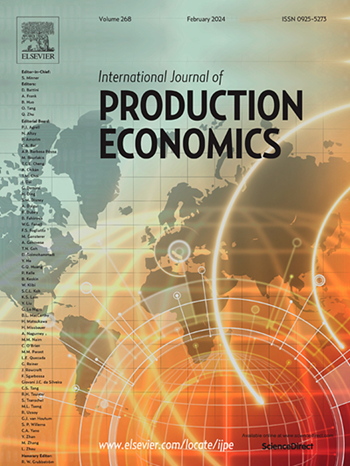The diverging control policy’s hand in supranational supply chain reconfiguration
IF 9.8
1区 工程技术
Q1 ENGINEERING, INDUSTRIAL
引用次数: 0
Abstract
The efficiency of supranational supply chains is frequently compromised by divergent and evolving policies across countries. A novel assessment method for prolonged disruptive circumstances is presented, wherein supply chain performance is influenced by various mitigating control policies. The impact of control policies with concomitant labor productivity losses and perturbed delivery capabilities in supply chain networks is demonstrated through a detailed epidemic case study with diverging control approaches. First, a game-theoretic framework is employed through which the cost-optimal Nash equilibrium profile of diverging control strategies between countries is determined. Subsequently, cost-based strategic options for supply chain relocation are revealed through numerical simulations, providing guidance for entrepreneurial decision-making. The analysis is conducted on a realistically designed multiplex network that integrates a supply chain network layer with the case study’s epidemic SEIRD-diffusion layer. Two interconnected countries with distinct GDPs are examined as they implement Nash equilibrium policies for Epidemic Control Cost (ECC). These policies are characterized by strong versus weak confinement, and higher versus lower vaccine efficiency. Through this innovative methodology, an explanation of policymakers’ diverging mitigation policies and the potential decisions for supply chain relocation toward the comparatively better-protected region are elucidated, with consideration given to each region’s Cost from Relocation and supply chain capacity Loss (LRC).
分散控制政策在超国家供应链重构中的作用
超国家供应链的效率经常受到各国不同和不断变化的政策的影响。提出了一种新的供应链绩效评估方法,其中供应链绩效受到各种缓解控制策略的影响。控制政策的影响,伴随着劳动生产率的损失和供应链网络中的交付能力受到干扰,通过一个详细的流行病案例研究与不同的控制方法来证明。首先,采用博弈论框架确定了国家间分散控制策略的成本最优纳什均衡。随后,通过数值模拟揭示了基于成本的供应链搬迁战略选择,为企业决策提供指导。分析是在一个实际设计的多路复用网络上进行的,该网络将供应链网络层与案例研究的流行病seird扩散层集成在一起。两个相互联系的国家具有不同的国内生产总值检查,因为他们实施纳什均衡政策的流行病控制成本(ECC)。这些政策的特点是强限制与弱限制,疫苗效率高与低。通过这一创新的方法,在考虑到每个地区的迁移成本和供应链能力损失(LRC)的情况下,阐明了政策制定者不同的缓解政策和供应链向相对保护较好的地区迁移的潜在决策。
本文章由计算机程序翻译,如有差异,请以英文原文为准。
求助全文
约1分钟内获得全文
求助全文
来源期刊
CiteScore
21.40
自引率
7.50%
发文量
266
审稿时长
52 days
期刊介绍:
The International Journal of Production Economics focuses on the interface between engineering and management. It covers all aspects of manufacturing and process industries, as well as production in general. The journal is interdisciplinary, considering activities throughout the product life cycle and material flow cycle. It aims to disseminate knowledge for improving industrial practice and strengthening the theoretical base for decision making. The journal serves as a forum for exchanging ideas and presenting new developments in theory and application, combining academic standards with practical value for industrial applications.

 求助内容:
求助内容: 应助结果提醒方式:
应助结果提醒方式:


